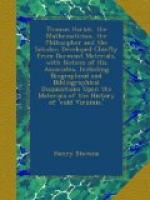This journal of Laudonnière carefully edited by Basanier was completed in time to be published in Paris in 1586, in French, in octavo. It was dedicated to Sir Walter Raleigh. Hakluyt translated it into English, and printed it in small quarto in London the next year and it reappeared again in his folio voyages of 1589. The French edition fell under the eye of Theodore De Bry the afterwards celebrated engraver of Frankfort, formerly of Liege. Whether or not this engraver was a relative of young De Bry of Florida is not known, but we are told that he soon sought out Le Moyne whom he found in Raleigh’s service living in the Blackfriars in London, acting as painter, engraver on wood, a teacher and art publisher or bookseller.
De Bry first came to London in 1587 to see Le Moyne and arrange with him about illustrating Laudonnière’s Journal with the artist’s maps and paintings, and remained here some time, but did not succeed in obtaining what he wanted, probably because Le Moyne was meditating a similar work of his own, and being still attached to the household of Raleigh was not free to negotiate for that peculiar local and special information which he had already placed at Raleigh’s disposal for his colony planted a little north of the French settlement in Florida, then supposed to be in successful operation, but of which nothing had yet been published to give either the world at large or the Spaniards in the peninsula a premature clue to his enterprise.
There is still preserved a good memorial of De Bry’s visit to London in the celebrated funeral pageant at the obsequies of Sir Philip Sidney in the month of February 1587, drawn and invented by T. Lant and engraved on copper by Theodore de Bry in the city of London, 1587. A complete copy is in the British Museum, and another is said to be at the old family seat of the Sidneys at Penshurst in Kent, now Lord de L’lsle’s; while a third copy not quite perfect adorns the famous London collectionof Mr Gardner of St John’s Wood Park.




